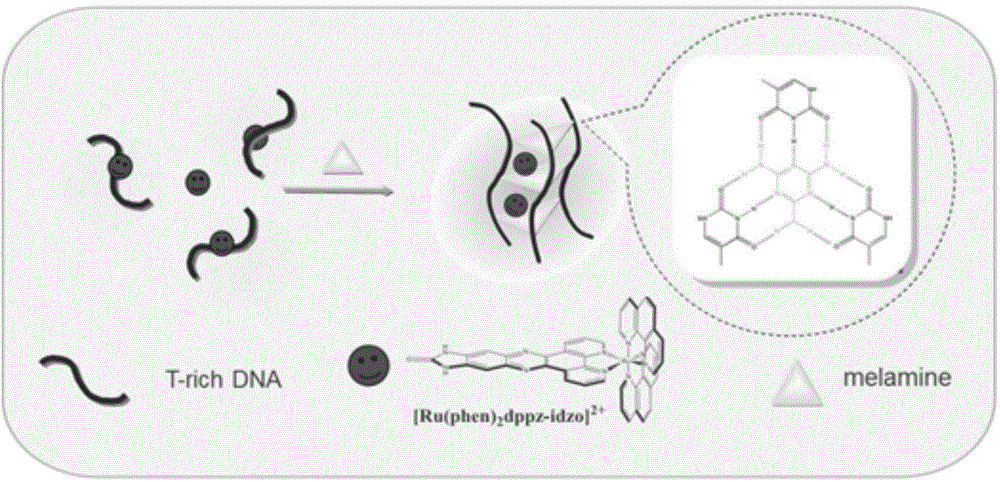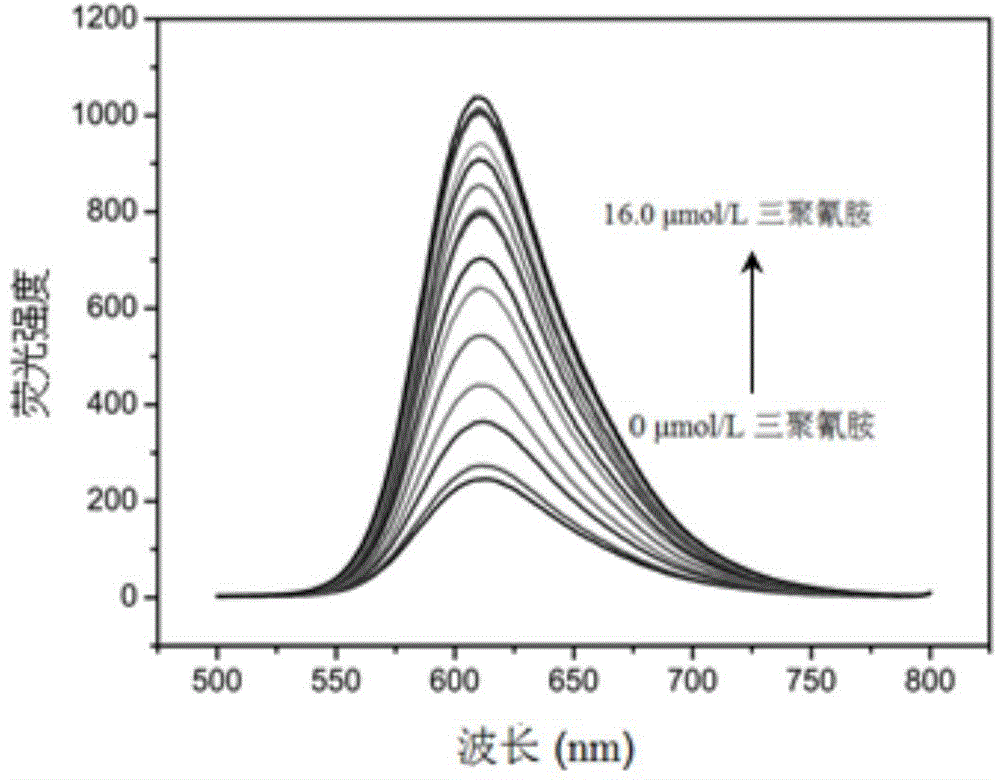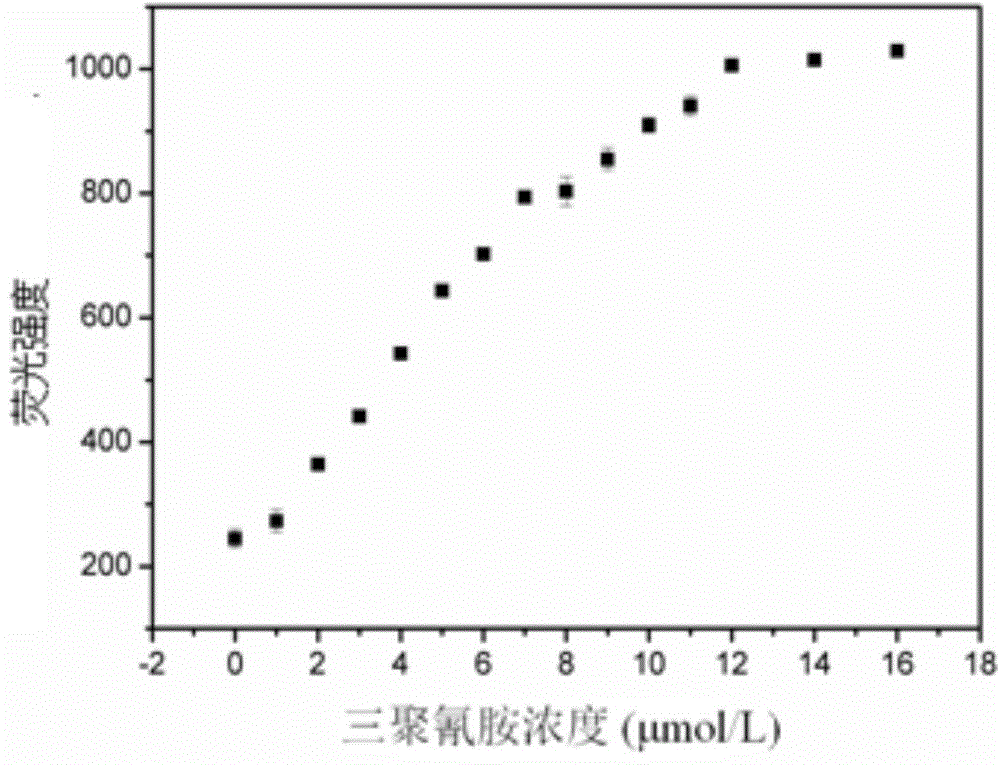Melamine fluorescence spectrum detection method based on metallic ruthenium polypyridine complex
A metal ruthenium polypyridine and melamine technology, applied in the field of melamine detection, can solve the problems of less melamine, kidney stones, malnutrition, etc., and achieve the effects of easy control, simple steps, and fast process.
- Summary
- Abstract
- Description
- Claims
- Application Information
AI Technical Summary
Problems solved by technology
Method used
Image
Examples
Embodiment 1
[0042] Fluorescent detection of melamine standard solution
[0043] (1) Interaction of rich T DNA and melamine
[0044] Dissolve the melamine to be tested in methanol to prepare standard test solutions of melamine with different gradients. Add 15 μL T30 (concentration: 100 μmol / L, sequence from 5' to 3': TTTTTTTTTTTTTTTTTTTTTTTTTTTTTTTT) into 15 centrifuge tubes (1.5mL) with a pipette gun, and then add different concentrations of melamine in sequence with a pipette gun. The test solution was diluted to 985 μL with 10 mmol / L Tris-HCl (pH 7.0) buffer. The mixture was incubated at room temperature for 15 minutes. T-rich DNA can form special three hydrogen bonds with melamine, thus forming a three-stranded structure. The T-rich DNA changes from a single-stranded structure to a triple-stranded structure.
[0045] (2)[Ru(phen) 2 dppz-idzo] 2+ Insert triplex structure
[0046] 15μL [Ru(phen) 2 dppz-idzo] 2+ (200 μmol / L) was added to the above mixture, and the system was incu...
Embodiment 2
[0052] selective research
[0053] (1) Cultivation of T-rich DNA sequences and interfering substances
[0054] Use a pipette gun to add 15 μL T30 (concentration: 100 μmol / L, sequence from 5' to 3': TTTTTTTTTTTTTTTTTTTTTTTTTTTTTT) into each centrifuge tube (1.5 mL), and then use a pipette gun to add a certain concentration of interfering substances ( Glycine, Histidine, Threonine, Valine, Lysine, Cysteine, Glucose, Ca 2+ , Mg 2+ , Zn 2+ , dicyandiamine, uracil, ATP, BSA) and melamine, diluted to 985 μL with 10 mmol / L Tris-HCl (pH 7.0) buffer. The mixture was incubated at room temperature for 15 minutes.
[0055] (2)[Ru(phen) 2 dppz-idzo] 2+ insert
[0056] 15μL [Ru(phen) 2 dppz-idzo] 2+ (200 μmol / L) was added to the above mixture, and the system was incubated at room temperature for 15 minutes. The final concentration of T30 is 1.5μmol / L, [Ru(phen) 2 dppz-idzo] 2+ The final concentration is 3.0 μmol / L. The final concentration of interfering substances was 10 μmol / L...
Embodiment 3
[0061] Sample spike recovery experiment
[0062] (1) Milk sample pretreatment
[0063] Add 2mL of pure milk and 1mL of melamine solutions of different concentrations into a 10mL centrifuge tube, add 2mL of triple distilled water, then add 1mL of acetonitrile and 1mL of methanol, vortex and shake for 1min to remove protein, and the mixture is ultrasonicated for 10min. Centrifuge for 10min. Filter with a 0.22 μm microporous membrane, take the supernatant, transfer to another centrifuge tube, and set aside.
[0064] (2) Culture of T-rich DNA sequences and milk samples
[0065] Use a pipette gun to add 15 μL T30 (concentration: 100 μmol / L, sequence from 5' to 3': TTTTTTTTTTTTTTTTTTTTTTTTTTTTTT) into each centrifuge tube (1.5 mL), and then use a pipette gun to sequentially add milk containing a certain concentration of melamine The sample was diluted to 985 μL with 10 mmol / L Tris-HCl (pH 7.0) buffer. The mixture was incubated at room temperature for 15 minutes.
[0066] (3)[Ru...
PUM
 Login to View More
Login to View More Abstract
Description
Claims
Application Information
 Login to View More
Login to View More - Generate Ideas
- Intellectual Property
- Life Sciences
- Materials
- Tech Scout
- Unparalleled Data Quality
- Higher Quality Content
- 60% Fewer Hallucinations
Browse by: Latest US Patents, China's latest patents, Technical Efficacy Thesaurus, Application Domain, Technology Topic, Popular Technical Reports.
© 2025 PatSnap. All rights reserved.Legal|Privacy policy|Modern Slavery Act Transparency Statement|Sitemap|About US| Contact US: help@patsnap.com



